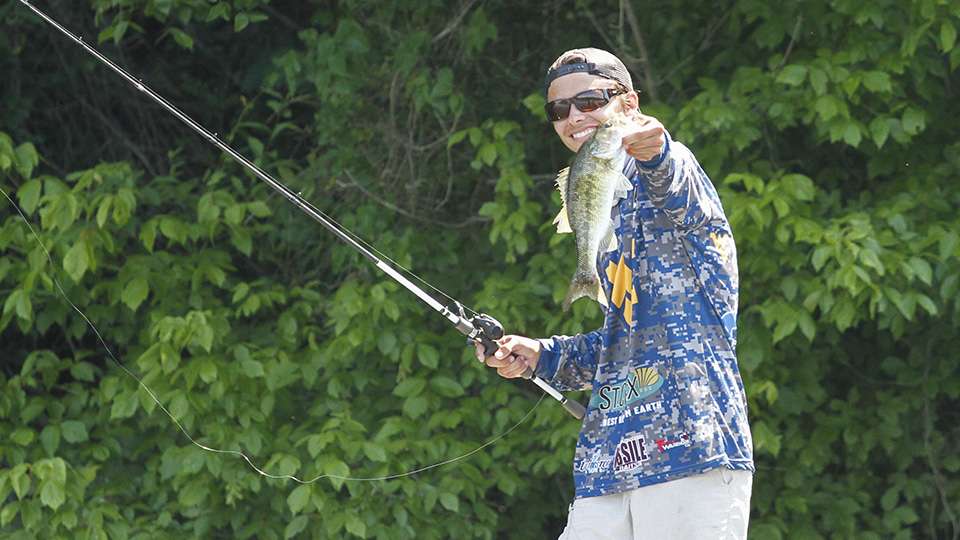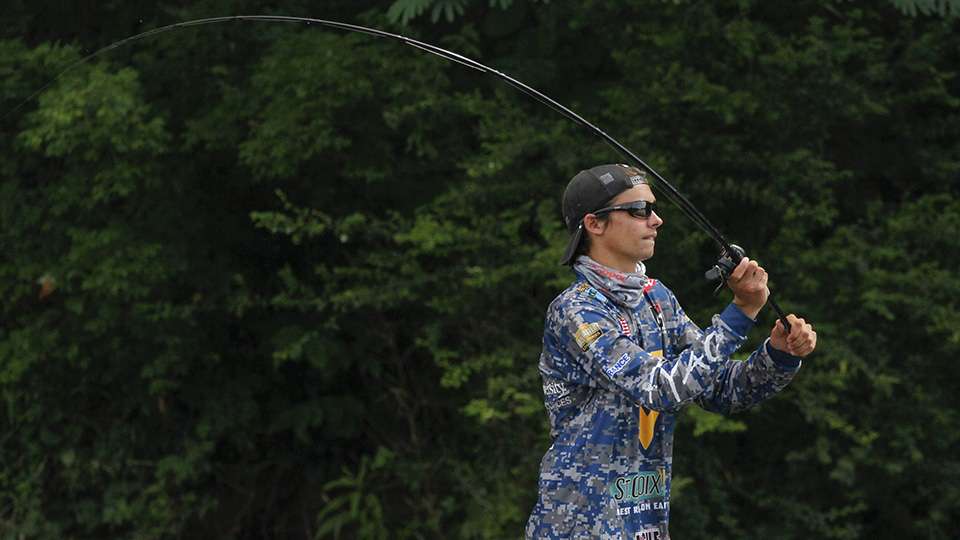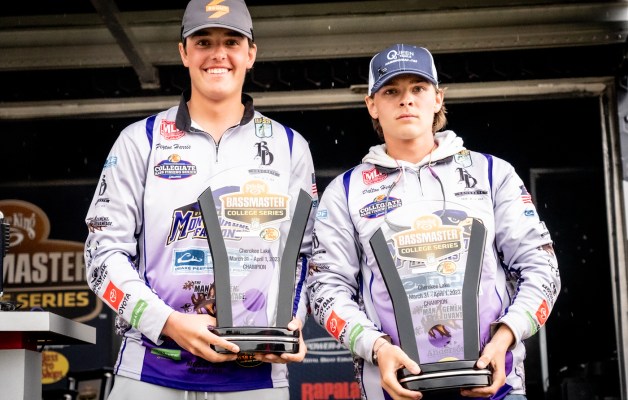
By Nolan Minor
Before dropping the boat at Beeswax Marina on Monday morning for the start of official practice, my partner Casey and I had never laid eyes on Lay Lake, or anything in Alabama for that matter. We had driven 643 miles from home to take one more shot at qualifying for the Carhartt Bassmaster College National Championship presented by Bass Pro Shops, and the idea of big mean spotted bass seemed very promising.
We spent our first day looking for largemouth in the grass, because from what everyone was saying, that is how the event would be won. The areas we fished looked amazing, and despite our efforts, we didn’t even get a bite for the entire morning. At this point we decided to start working our way up the river and see if things changed. We figured this would be a good move, as neither of us are strangers to fishing current. I spend a lot of time back home in central Virginia kayaking rivers for largemouth and smallmouth. Casey lives in North Carolina on the Cape Fear, Haw and Deep River, where he also kayak fishes in the current for largemouth. Day one did not yield much. We made it a very long way up the river, burning nearly all of our gas, with only three small keeper Coosa spotted bass to show for it.
On day two, we decided to completely change our game plan and try further down the lake again for largemouth in the grass. It stayed overcast and rainy for most of the morning, which seemed ideal for what we were doing. Despite this, all the activity we found was when I managed to get one single blowup on a frog. After only two hours of that, we scrapped that idea, put the boat on the trailer, and headed back to the hotel to wait for the storms to clear off.
One thing we noticed while we were down the lake is that there was very noticeable current. The rain had been pouring off and on for most of the time we were there, and we were worried it may have blown out the river, which seemed like our only option even though we did not catch much up there. As we sat in the hotel room trying to make a game plan, wheels spinning, I thought back to an Bassmaster Elite Series event that reminded me of what we were facing, the Alabama River Charge in 2013. The event was held further downriver from where we were, below Jordan Lake. The pros experienced extreme rainfall, current and changing water levels throughout the event. Despite that, most at the top of the leaderboard were all running way up the river and fishing near Jordan Dam, in what seemed to be some pretty scary conditions. So we decided it was time to haul the boat to a ramp very close to Logan Martin Dam and see if there were any parallels.
Once we made it out of the creek the ramp was in, we were shocked by the amount of current in the river. The 70-pound thrust trolling motor could barely make headway pulling my little 17-foot aluminum tracker, which is a pretty easy boat to move around. While this seemed intimidating, it meant one thing, the fish had to go to the banks, they couldn’t sit in the main river. We worked a couple stretches of bank, then headed up to the dam for an hour or so, but our high hopes began fading when we had spent three hours fishing without a bite.
We ran a little further downriver, and stopped where a creek entered the river, creating a large current break. On my first cast with a jig, I got bit, and on my second cast, I caught a 12-inch spot. Nothing too promising, but when the next 10 casts all yielded either a fish or a bite, we knew we were on to something. We then started to try and duplicate what we found in this area, looking for current breaks and creeks feeding into the river. In the amount of time remaining before it got dark, we landed about 25 Coosa spots, and a handful of them were in the 17- to 19-inch range. The number of fish we were around was astonishing, many times you could cast to the same eddy five times in a row and catch a fish on every cast.

Our final day of practice was spent in the same area patterning the fish and marking waypoints in the areas where we found large groups of them. Even though we shook off about 10 fish for every one we set the hook on, I bet we still put 25 of them in the boat. What shocked me about a Coosa spot is that they will continue to eat your jig over and over despite you shaking them off, some would even follow it all the way to the boat, eating the bait six or eight times in one cast.
We spent enough time in the same types of areas that we started to figure out the nuances of the bite. A 1/2-ounce finesse jig was key, anything lighter did not fall fast enough to get bit, as well as getting blown away in the current. We had to drift the jigs on current seams, and almost stroke the jig as it moved along, ripping it up about a foot and letting it fall, these fish would rarely bite on the initial drop. The trailer we selected was a Zoom Ultravibe Speed Craw. The slim profile helped to keep the bait down in the current, and the intense kicking action that the tails put off, in my opinion, gave the fish something to hone in on in the swirling waters of the eddys and current breaks we fished. We fished the jigs on 15-pound fluorocarbon. I would have felt better with 20-pound, as these were without a doubt the meanest bass I have ever fished for, but in the current, the bigger diameter of 20 just created too much drag and there was a big bow in the line. A jig was pretty much the only bait we could present to the fish, 8-15 feet of depth right off the bank in heavy current would not allow most baits to get down. We tried heavy swimbaits and heavy spinnerbaits but they just stayed too high in the water column.
Day 1 of the event went extremely well, we were able to catch a nice limit off of our spots from practice, and then go find new water following our pattern in order to save some fish for day two. The river had dropped about a foot and the current had slowed some, but we just backed off our spots a little bit and so had the fish. We caught at least 40 keepers, and it’s nerve wracking throwing back so many decent fish in a multi day event, but we knew we had to weed through them in order to get those better fish that were just a few ounces heavier. The dropping water also revealed something else to us. There were tons of bushes in the water, and the spots did not like holding in these at all, they were mainly on bare patches in between the bushes, and with the lower water, we could now see the clay banks that clearly held the most (and larger) fish.
Day 2 went well again, with around 40 keepers again. The water had continued to drop, which eliminated some of our areas due to lack of depth, and the slower current also eliminated some spots. If the bank did not have enough current pushing on it, it held no fish. We backed out even further off of some our spots, and as with day one, the fish had pulled out off the banks with the dropping water and slowing current. The slower current also caused the fish to form bigger schools, so while they weren’t in as many areas, when you did find a group of them, it was often 10-15 bass back to back. Once they shut down, you could not get a bite and had to go searching for others.
Day 3 was a huge change for us. In total, the river was down about 5-6 feet from practice, and the current had significantly slowed. Only two of our roughly 30 waypoints held groups of fish, because they were deeper, and in a narrower part of the river where the current picked up. Since the current was so much slower, the spotted bass now had the freedom to roam and chase shad, which we saw them doing. Our initial limit came off of one spot where we saw sporadic breaking fish on the surface. We also used a completely different bait, a deep diving crankbait, which we selected because these fish were now keying on shad, and also because the Day 2 leader, Josh Butts, had recommended it to me.
After we got our limit, the sun got higher and the fish quit chasing shad. We went back to our jigs, and managed to get a couple bites, but the fishing was slow. We ended up running closer to the dam where we knew the current would be stronger to get our last couple culls in for the day, which ended up being more than enough to qualify us for the National Championship.
Lay Lake was a blast, the spotted bass population in the river was absolutely astonishing, the people were great and I will remember it forever. I am really looking forward to seeing what the remainder of my College fishing career has in store for me!




